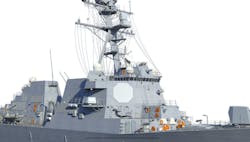Raytheon to develop software algorithms to enable surface warships to operate in receive-only stealth mode
ARLINGTON, Va. – U.S. Navy researchers are asking Raytheon Technologies Corp. to develop detection algorithms and operating modes for the shipboard AN/SPY-6(V) Air and Missile Defense Radar (AMDR) to improve at-sea situational awareness -- particularly when the host ship operates in non-transmit stealth mode.
Officials of the Office of Naval Research (ONR) in Arlington, Va., announced a $29.2 million contract Tuesday to the Raytheon Missiles & Defense segment in Tewksbury, Mass., for the Receive Only Cooperative Radar (ROCR) system.
The ROCR project seeks to develop a receive-only capability for the AN/SPY-6(V) AMDR that improves situational awareness during emissions control (EMCON) and improves radar timelines with advanced waveforms for communications and radar operations.
EMCON helps prevent an enemy from detecting, identifying, and locating the radar's host ship, and can minimize electromagnetic interference aboard ship, and among nearby vessels. Naval commanders assume that any electromagnetic radiation immediately will reveal the position of the transmitting ship to an enemy.
Navy researchers are asking Raytheon to develop new detection algorithms and operating modes for the AN/SPY-6(V)1 radar system, which will improve detection and tracking capabilities of the radar system.
Radar systems operating in receive-only mode aboard surface warships still can gather some information on the range and bearing of friendly and enemy forces by receiving radar return signals from other radar transmitters -- either hostile or friendly.
At the same time, a receive-only radar can help conceal the host ship's position, range, and bearing from the enemy by restricting transmission of radar signals.
Raytheon will model and simulate new operating modes, revise software code to incorporate new algorithms, integrate algorithms into demonstration hardware, and perform field tests using AN/SPY-6(V)1 demonstration hardware.
story continues below
The AN/SPY-6(V) AMDR is for late-model Arleigh Burke-class (DDG 51) Aegis destroyers, and can improve the ship's ability to detect hostile aircraft, surface ships, and ballistic missiles. The AMDR will supersede the AN/SPY-1 radar, which has been standard equipment on Navy Aegis Burke-class destroyers and Ticonderoga-class cruisers.
The new shipboard radar will go aboard Flight III Burke-class destroyers. Thus far two Flight III Burke-class destroyers are under contract: the USS Jack H. Lucas (DDG 125); and the USS Louis H. Wilson Jr. (DDG 126).
Flight III Burke-class destroyers approved for construction are the USS Ted Stevens (DDG-128); USS Jeremiah Denton (DDG-129); USS William Charette (DDG-130); USS George M. Neal (DDG-131; USS Quentin Walsh (DDG-132); USS Sam Nunn (DDG-133); USS John E. Kilmer (DDG-134); USS Thad Cochran (DDG-135; and the USS Richard G. Lugar (DDG-136).
The new Flight III versions of the Burke-class destroyers are under construction at Huntington Ingalls Inc. in Pascagoula, Miss., and at the General Dynamics Corp. Bath Iron Works segment in Bath, Me. Flight III is the latest version of the Burke-class guided missile destroyer.
Related: Navy orders 12 advanced AN/SPQ-9B shipboard radar systems from Northrop Grumman
The AN/SPY-6(V) AMDR will provide greater detection ranges, increased discrimination accuracy, higher reliability and sustainability, and lower costs, compared to the AN/SPY-1D(V) radar onboard today’s Burke-class destroyers.
The system is built with individual building blocks called radar modular assemblies (RMAs), Raytheon officials say. Each RMA is a self-contained radar in a two-cubic-foot box; RMAs can stack together to form any size array to fit ship mission requirements.
The inherent scalability of the AN/SPY-6(V) AMDR also could enable new instantiations, such as backfits on existing Burke-class destroyers and installation on aircraft carriers, amphibious warfare ships, frigates, the littoral combat ship, and Zumwalt-class land-attack destroyers without significant new radar development costs, Raytheon officials say.
For the Flight III Burke-class destroyer's SPY-6(V) AMDR will feature 37 RMAs. The new radar will be able to see targets half the size at twice the distance of today’s SPY-1 radar. The AMDR will have four array faces to provide full-time, 360-degree situational awareness. Each 14-by-14-foot face is about the same size as today’s SPY-1D(V) radar.
Related: Stealthy USS Zumwalt land-attack destroyer to fire new missiles and laser weapons
The AN/SPY-6(V) AMDR will 30 times more sensitive than the AN/SPY-1D(V) in the Flight III configuration, and is being designed to counter large and complex raids, Raytheon officials say. The new radar will have adaptive digital beamforming and radar signal processing for dealing with high-clutter and jamming environments.
The AN/SPY-6(V) radar also is reprogrammable to adapt to new missions or emerging threats. It uses high-powered gallium nitride (GaN) semiconductors, distributed receiver exciters, adaptive digital beamforming, and Intel processors for digital signal processing.
The new radar will feature S-band radar coupled with X-band horizon-search radar, and a radar suite controller (RSC) to manage radar resources and integrate with the ship’s combat management system.
On this contract Raytheon will do the work in Marlboro, Mass., and Fairfax, Va., and should be finished by May 2023. For more information contact Raytheon Missiles & Defense online at www.raytheonmissilesanddefense.com, or the Office of Naval Research at www.onr.navy.mil.
About the Author
John Keller
Editor-in-Chief
John Keller is the Editor-in-Chief, Military & Aerospace Electronics Magazine--provides extensive coverage and analysis of enabling electronics and optoelectronic technologies in military, space and commercial aviation applications. John has been a member of the Military & Aerospace Electronics staff since 1989 and chief editor since 1995.
